At this time of year our colleagues Jill and Matteo are finishing the vital job of cleaning seed from the 2022 wildflower and wild grass seed harvest at Mavisbank, home of Scotia Seeds. From September onwards Jill starts the process of taking the ‘rough’ seed, which was dried after harvest and then separating pure seed from bits of dried plant and any other bits and pieces.

As we grow over 200 different wildflower species, with seeds of different sizes, weights, shapes and textures Jill has a different cleaning protocol for each one. Here she is working with Devil’s-bit Scabious (Succisa pratensis). Like many of our species the seed of this plant starts its cleaning process at harvest – some of Devil’s-bit Scabious crop is hand picked but a lot of it is collected with our small combine harvesters, which, as they thresh what they harvest, begin the cleaning process by starting to separate leaves and stems from seeds. Later, after drying, the main cleaning begins in our seed cleaning hall. In the case of Devil’s-bit Scabious, the seed is first put through a static thresher which uses a combination of bashing the material a bit and blowing off some of the waste. Next the seed is put through a seed cleaner that uses a series of moving screens – sheets of metal with holes in. The seed drops through the screens and unwanted material is caught and moved off. Next the seed moves on to another, smaller cleaner working in the same way. The last machine the Devil’s-bit Scabious seed goes on to is the indented cylinder seen here. The aim here is to catch the smaller seed which falls into the dimples on the inside of the drum. As the drum turns, the seed is carried up to the top and dropped into the channel that goes into one container, whilst the unwanted, longer material isn’t taken up and is dropped out below. Sometimes the last two stages have to be repeated more than once.
For each species of wild plant a subtly different combination of machines is used; perhaps not in the same order but all based on sorting seed from chaff using screens, sieves, blowing air &/or catching seed based on shape, size or surface texture.
A wildflower species like Violet (Viola riviniana) is interesting as its seed grows in small pods – quite easy to clean as, when the pods dry they open up and the small, round seeds are released and Jill can sieve off the dried pods. Any stubborn pods are put through a brusher machine to release the seed.
Jill is used to working with the same species each year and so is intrigued when a new species comes into production and she has to devise a new way through the cleaning process for its particular seed!
After seed is cleaned it is ready to go on to the next stage; seed testing…
